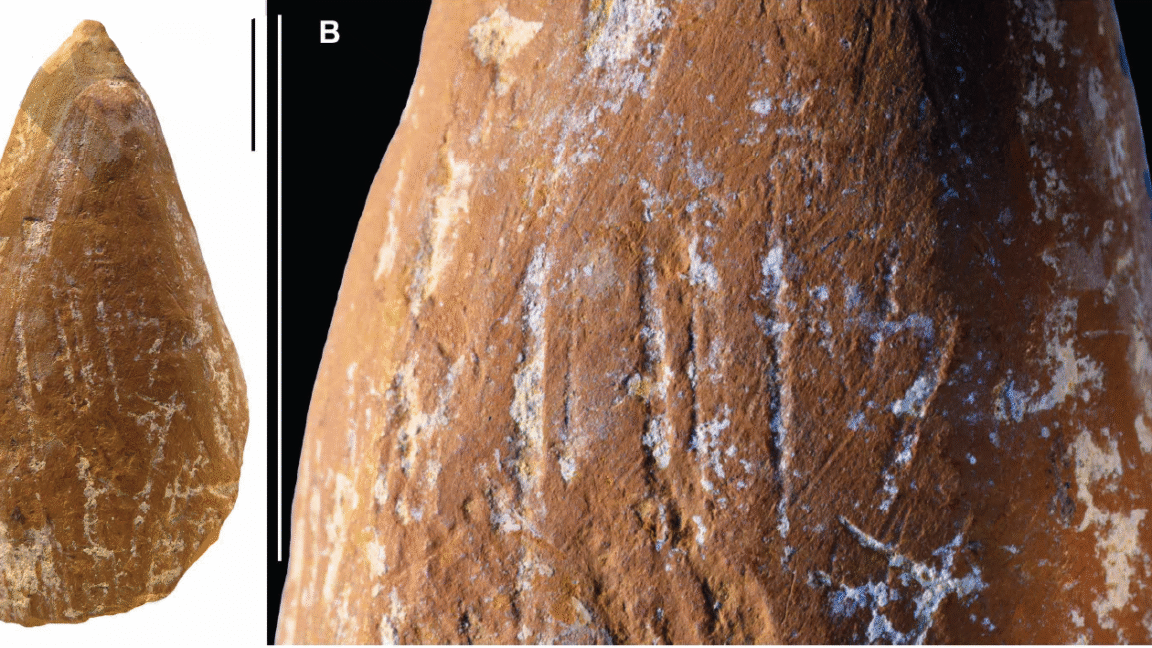Science
Neanderthals Crafted Crayons, Revealing Artistic Abilities

Recent findings indicate that Neanderthals in Crimea crafted ocher crayons, showcasing their artistic capabilities. Two pieces of ocher, dating back approximately 47,000 and 46,000 years, exhibit distinct wear marks, suggesting they were intentionally shaped and sharpened for use as drawing tools. A third piece, engraved with parallel lines, underscores the complexity of Neanderthal cultural practices.
These artifacts were discovered in rock shelters near the modern city of Bilohirsk, located on the southern Crimean peninsula. Archaeologists have been excavating these sites, which were inhabited by Neanderthals between 100,000 and 33,000 years ago. The ocher pieces, rich in iron, have been identified as suitable for various uses, including creating pigments and tools.
Research led by David D’Errico and his team employed X-ray fluorescence and scanning electron microscopy to analyze 16 ocher chunks, uncovering their potential applications. While many of the ocher pieces could have served multiple purposes, two distinct artifacts from a site known as Zaskalnaya V stood out.
One of these, measuring 44.8 millimeters in length and 23.3 millimeters wide, was fashioned into a pointed crayon shape and showed signs of repeated resharpening. D’Errico noted, “The shaping, wear, and resharpening indicate they were used to draw or mark on soft surfaces.” The second artifact, a 25.4-millimeter piece of red ocher, resembled the yellow crayon but had a broken tip.
The third artifact from Zaskalnaya V, an orange ocher piece, features several deep, parallel lines engraved into its surface. The wear and polish suggest it was handled extensively, possibly carried for years. D’Errico commented on the significance of these markings, highlighting the possibility of intentional design by a right-handed individual.
These discoveries contribute to a growing body of evidence suggesting that Neanderthals engaged in cultural expressions previously thought to be exclusive to modern humans. D’Errico and his colleagues emphasized that the sophisticated use of ocher reveals a complex cultural life among Neanderthals, challenging traditional views of their cognitive capabilities.
They pointed out that the symbolic and utilitarian functions of ocher likely intertwined, indicating that these early humans may have ascribed meanings to the colors they used. This notion is supported by the existence of other Neanderthal artifacts, including 57,000-year-old finger markings in France and 114,000-year-old ocher-painted shells in Spain.
The implications of this research extend beyond the confines of artistic expression. The evidence suggests that Neanderthals were capable of creating nuanced cultural practices long before the arrival of Homo sapiens in Eurasia. The findings reinforce the idea that the desire to create art is deeply rooted in our shared evolutionary heritage.
As excavations continue in Crimea, further revelations about Neanderthal life and culture are anticipated. This ongoing research not only enriches our understanding of these ancient peoples but also invites contemplation about the origins of artistic expression in human history.
The full study is published in the journal Science Advances, underscoring the importance of interdisciplinary approaches in archaeology and anthropology.
-

 World4 months ago
World4 months agoScientists Unearth Ancient Antarctic Ice to Unlock Climate Secrets
-

 Entertainment4 months ago
Entertainment4 months agoTrump and McCormick to Announce $70 Billion Energy Investments
-

 Lifestyle4 months ago
Lifestyle4 months agoTransLink Launches Food Truck Program to Boost Revenue in Vancouver
-

 Science4 months ago
Science4 months agoFour Astronauts Return to Earth After International Space Station Mission
-

 Technology2 months ago
Technology2 months agoApple Notes Enhances Functionality with Markdown Support in macOS 26
-

 Top Stories3 weeks ago
Top Stories3 weeks agoUrgent Update: Fatal Crash on Highway 99 Claims Life of Pitt Meadows Man
-

 Sports4 months ago
Sports4 months agoSearch Underway for Missing Hunter Amid Hokkaido Bear Emergency
-

 Politics3 months ago
Politics3 months agoUkrainian Tennis Star Elina Svitolina Faces Death Threats Online
-

 Technology4 months ago
Technology4 months agoFrosthaven Launches Early Access on July 31, 2025
-

 Politics4 months ago
Politics4 months agoCarney Engages First Nations Leaders at Development Law Summit
-

 Entertainment4 months ago
Entertainment4 months agoCalgary Theatre Troupe Revives Magic at Winnipeg Fringe Festival
-

 Top Stories1 week ago
Top Stories1 week agoFamily Remembers Beverley Rowbotham 25 Years After Murder









